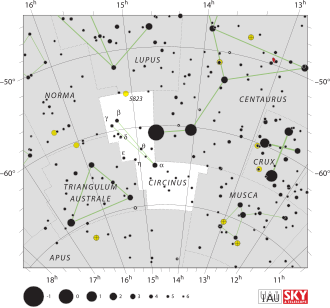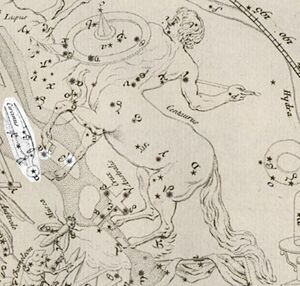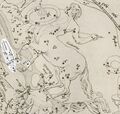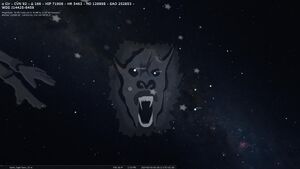Circinus
One of the 88 IAU constellations. The constellation was taken over in the 1920s.[1]
It was invented in Cape Town in the early modern era, when the Cape Colony, the settlement around the Fort de Goede Hoop (Castle of Good Hope) slowly grew. At that time, the place was a way-station for European ships to the archipelago now called Indonesia where tobacco, copper and iron was traded with the Khoekhoe clans of the region in exchange for fresh meat and other important travelling implements.
Etymology and History
In the 16th century, the Dutch cartographer Plancius commissioned two ship navigators to bring back star charts from the East Indies exploration - they formed the constellation ‘Southern Triangle’ (Triangulum Australe) under the Centaur, which consists of four stars similar to the classical Greek constellation of the triangle: one on each point and another in the centre of the baseline of the isosceles triangle. Between this and the centaur's hoof, there was a gap into which the French astronomer and surveyor Nicolas de Lacaille squeezed the figure of a circle around 160 years later. The constellation consists of three stars intended to represent the slender folded drawing tool. He may well have symbolised one of his most important daily tools here.
Lacaille named the constellation in French Le Compas and grouped[2] them together with Norma (his invention) and the Southern Triangle (Triangulum Australe) invented earlier by the Dutch.
Image Gallery
Indigenous Constellations in this Area
In this area adjacent to the third brightest star of the night sky, Indigenous cultures have not named individual stars (other than α and β Centauri). The main star of the constellation Circinus, α Cir, has hence been nameless.
The South African people of the Khoekhoe who lived in the area at the time when the constellation was invented, have named the two bright stars "the eyes of the beast" (Xami Di Mura), where the beast (xami) is a lion and the two eyes are "mura". If the two bright stars are imagined the eyes, the face of this creature is seen in the adjacent areas, covering also the star α Circini.
The language groups of Khoe and San cover a wide range each. Most of these languages are now moribund. The Khoekhoe dialect \Xam is one such language which was fortunately recorded, however there are no speakers surviving.
IAU WGSN Catalog of Star Names
In 2024, it was suggested to use the Khoe term "Xami" (from the \Xam dialect) to designate the star Circini with a term from one of the peoples who are native to the place where the constellation was invented.
Weblinks
- South African Astronomical Observatory (SAAO) in Cape Town.
References
- ↑ Ian Ridpath's Star Tales (online edition on Circinus).
- ↑ Ian Ridpath's Star Tales (on grouping online edition)









